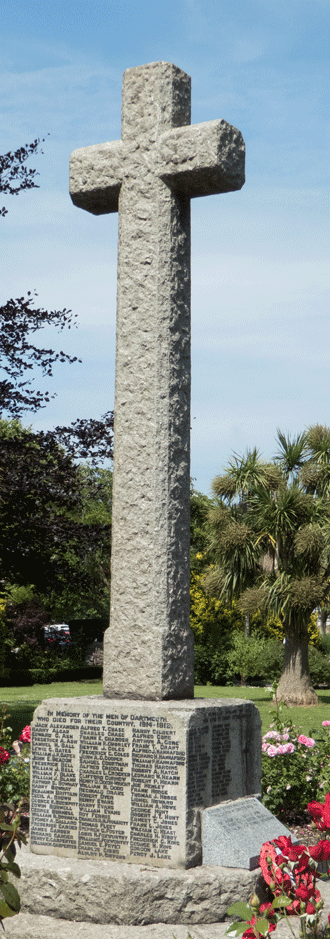Arthur Sanders Bowhay
Family
Arthur Sanders Bowhay was born in Dartmouth in 1895 and baptised at St Petrox on 18th September of that year. He was the third son and fifth child of Albert Bowhay and his wife, Mary Jane Sanders. For his family background, see the story of his younger brother, George Henry (Harry) Bowhay, who was killed in action with the 8th Devons at Ecoust, near Arras, in March 1917.
According to a history of the family, "Arthur inherited a feeling for the land and took up gardening in addition to helping his father on the farm. When only 18 he was winning prizes for his employer, Reverend Simpson, in the vegetable classes at the Dartmouth Kingswear and District Agricultural and Cottage Garden Society Annual Exhibition, in October 1913."
Service: Devonshire Regiment
Arthur's service papers have not survived. However, from the columns of the Dartmouth Chronicle published in the early years of the war, listing the names of those serving in the Forces, we know that he had certainly joined the 7th Battalion Devonshire Regiment (Cyclists) by 25th June 1915. His Devonshire Regiment service number was 2004, and on transfer to the 10th Battalion of the Worcestershire Regiment he was given another service number, 207241. The surviving papers of men of the Worcestershire Regiment with near numbers to Arthur's indicate that there was a contingent from the Devon Cyclists to the 10th Battalion who transferred to the 10th Battalion on 12th April 1918. This is confirmed by information about Arthur's service published in the Dartmouth Chronicle at the time of his death, see below.
The 7th Battalion of the Devonshire Regiment were created as part of the Territorial Force in 1908. By 1914 there were several cyclist companies: F Company was based at Dartmouth. Several men on our website were members of F Company before the war - for example, Harold Mandley, who joined in 1910, and Frederick Coles, who rejoined on 7th August 1914. The Cyclists, as a Territorial unit, were mobilised at the outbreak of war. For the first few days they were involved in coastal defence locally, but very soon were sent to the north-east coast. For their experiences there, see the story of Frederick Thomas Bell who joined up in early October 1914. The activities of the unit were followed with close interest by the Dartmouth Chronicle during the first few months of the war.
During 1915 the Cyclists continued to recruit, for example, advertising in the Western Times on 23rd September 1915:
An opportunity occurs for men to join the popular 7th Devon Regiment (Cyclists) … a really popular unit which has always attracted the best class of men. Applicants should be 19 years of age or more and are expected to sign for Imperial service. The training quarters for the winter will probably be at Paignton. The usual rates of pay and separation allowances are made. The officers are popular, the work pleasant, and any young fellow looking for a regiment to join will be fortunate if he is accepted for this one.
Arthur first joined the training battalion (3rd/7th - this seems to have existed only for a year or so in 1915-1916) and then was posted to the 2/7th, formed in September 1914 and based at Totnes. Meanwhile, the 1/7th had returned from the north-east to Devon, being based at Seaton. In December 1915, approximately six months after Arthur joined, both Battalions moved to the south-east, on their bicycles - the 1st/7th moved to Kent and the 2nd/7th to St Leonards on Sea in Sussex. The Shepton Mallet Journal of 3rd December 1915 reported:
Two Battalions of cyclists of the 7th Devon Regiment passed through the city on Saturday and Tuesday last respectively, on their way to Frome and London. The novel spectacle soon attracted a crowd of sightseers, who cheered the men on their journey.
At the beginning of the war, recognising that the purpose of the Territorial Force was home defence, there was no obligation to sign up for overseas service, though many men did so. During 1915, as the advertisement quoted above indicates, recruits were "expected to sign for Imperial service", and with the introduction of conscription in 1916, the limitation on Territorial Force members serving overseas was no longer relevant. A large contingent of Devon Cyclists, including several from Dartmouth, transferred in 1916 to the Worcestershire Regiment and were sent to France, but Arthur was not one of these. He remained on home service in south-east England - 2nd/7th moved in 1916 to Sevenoaks, in 1917 to Margate and to Southminster, Essex, in 1918. The Cyclists' role was home and coastal defence and assistance to the civil powers as required.
In 1916 Arthur's mother Eliza died. According to the family's history, he returned to Dartmouth for the funeral. This was most probably the last time he saw his younger brother Harry, who was also able to attend.
Marriage
On 17th October 1917, at St Saviours in Dartmouth, Arthur married Norah Annie Adams. The marriage register records that Arthur was at that time a Corporal in the 2/7th Devons, and gave his home address as Crowthers Hill, where his parents lived. Norah was the only child of Frederick George Adams and his wife Emma Jane Callard. In 1911 she and her parents lived at 3 Sea View, Above Town, and Frederick worked as a foreman for one of Dartmouth's coaling companies. Norah, aged 15, worked as a dressmaker. By the time of Arthur and Norah's marriage, Frederick worked as a boatman.
Service: Worcestershire Regiment
Arthur and Norah's married life together was only a few months, most likely only a few weeks in practice. From a study of men whose service papers have survived and whose Worcestershire Regiment service numbers are close to Arthur's, it appears likely that he was sent to France on or about 12th April 1918. The contingent from the Devon Cyclists sent overseas were posted briefly to 2nd Devons on their arrival in France the following day, and then transferred to the 10th Battalion of the Worcesters, joining them "in the field" around 21st-25th April 1918. It appears that by this time Arthur had been promoted to Sergeant in the Devons, and he retained this rank in the Worcesters (according to the Worcestershire Regiment medal roll).
In early January 1918 the 10th Battalion, part of 19th Division in Third Army, had moved into the line at Marcoing, near Cambrai, and after a month moved back for a period of rest and training near Bapaume. In early March they were south of Bapaume, in Barastre, positioned in the "Battle Zone" area of the British Army's new system of "defence in depth", and were still there when the German Spring Offensive began on 21st March 1918. In the bitter fighting of 21st-26th March, Third Army had to fall back to maintain contact with the fast-retiring left of Fifth Army, where the German advance was greatest. The 10th Worcesters were finally withdrawn from the battlefield when reserves arrived, on 28th March, and were transferred to Flanders.
The unit's War Diary is missing for the period of March-June 1918 so the account here of their activities comes from the Regimental History. This notes that there are no figures for the 10th Worcesters' casualties during 21st-26th March. However, the 19th Division as a whole had lost much of its fighting strength on the Somme and the limited period of rest and recuperation now enabled by events was far from enough.
On 31st March they arrived in the front line east of the Messines Ridge, where they remained for the next ten days. They were due for relief on 9th April, but as this was the start of the next phase of the German spring offensive, the relief was cancelled and they remained where they were. The following day, they were overwhelmed by German attacks all along the Messines Ridge. In the desperate fighting that day and during the following eight days, the 10th Worcesters lost 378 officers and men. On 19th April, they were relieved by French troops, and were brought together with the remains of 19th Division in the Proven area. It would appear that the men who transferred from the Devon Cyclists joined their new battalion while they were at Proven. They were much needed reinforcements, but they had very little time to get used to their new unit and their new circumstances.
Almost immediately they had arrived, the 57th Brigade, including the 10th Worcesters, were brought forward to support the French attack on Kemmel Hill, on 26th April; but "the failure of the French to capture the hill caused the whole operation to be abandoned, and after forty-eight hours of discomfort in the support positions the 57th Brigade was sent back, after dark on 27th April, to a camp near Poperinghe".
They were ordered forward again on 29th April, the last of the German attacks of the Battle of the Lys, but were not involved in any fighting, and sustained no casualties. They remained in Flanders until the middle of May, temporarily attached to the 58th Brigade, and holding trenches between Dickebusch and the Ypres-Commines Canal. No attack developed against the Brigade front during the next ten days. Finally, they were relieved overnight on 11th/12th May, and marched back to Poperinghe.
The Battle of the Aisne
The French front further south had previously been a quiet sector, and it was decided that British divisions which had been worst-hit during the fighting on the Somme and the Lys should now be transferred there. The French divisions thereby relieved would then be available to Field Marshal Foch, now Supreme Commander of the Allied forces, to deploy as and when required. The first British Divisions arrived on the French front in late April and the 19th Division was sent to join them two weeks later, joining the French Fourth Army, east of Reims. The 10th Worcesters left Flanders on 16th May and arrived at Chalons three days later.
The Regimental History observes of this period:
The business of absorbing reinforcements was indeed the main preoccupation of all the three Worcestershire battalions in Champagne. All three Battalions had suffered heavily in March and April; only a mere cadre was left of officers, NCOs, and old soldiers experienced in war; and the ranks of the companies were now filled by young boys, mostly under twenty years of age, brought straight from the training battalions at home - the last reserve of England.
Arthur's transfer from the Devons, together with the other men who transferred with him, was the result of the severe casualties incurred during this period. Although he had served since 1915, and had reached NCO rank, he had no experience of fighting, and as events turned out, was given very little time to make up this deficiency. The fatal flaw in the otherwise sensible plan for the transfer of these heavily-hit British Divisions to the Aisne was that this area was the location chosen by the Germans for their next offensive. Their intention was to reach the Aisne River, and draw in Allied reserves before launching a final new assault in Flanders in July, which would achieve complete breakthrough and overall victory.
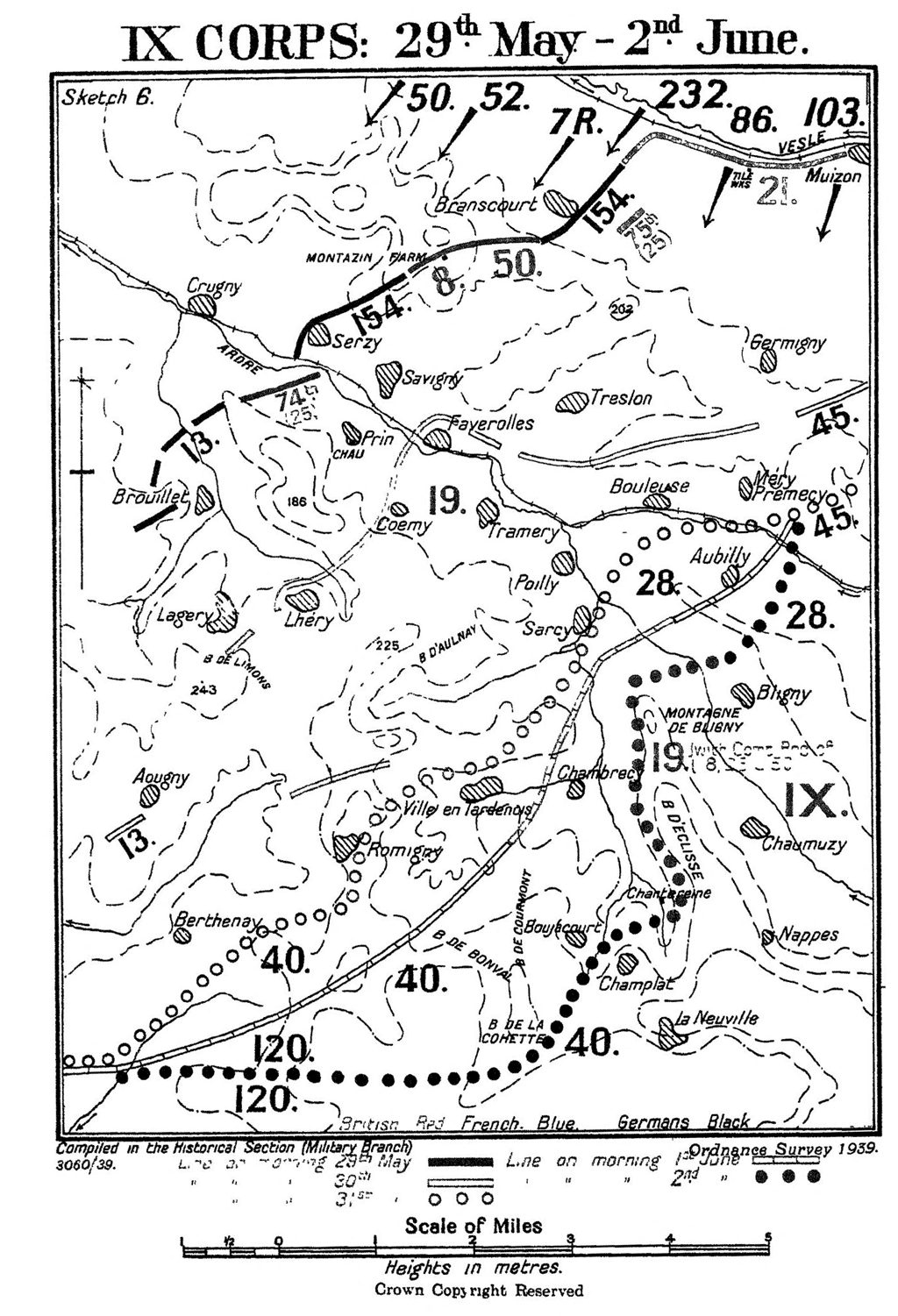
The attack was launched on 27th May in overwhelming strength (see the story of Percival Hannaford). The 57th Brigade was not on the front line but in training east of Reims. They were brought into the battle area quickly, arriving overnight on 28th/29th May. During 29th May, the 10th Worcesters entrenched along the line of the road between the villages of Coemy and Lhery, west of Reims (now the D27).
At dawn on 30th May 1918, the Germans again attacked in force:
Wave after wave … struck the salient formed by the left flank trenches of the 10th Worcestershire. The enemy were shot down in swathes, but their numbers enabled them to close with the bayonet. Twice their attacks were repulsed, but when the second German wave had been beaten back, the left flank company of the 10th Worcestershire had lost all its officers and two thirds of its total strength. The forward positions could be held no longer, and Colonel Sole ordered the company to fall back behind the village into line with the reserve company of the Battalion … Attack followed attack; but the smoke of the burning village aided the defence, and for a time the 3rd and 10th Worcestershire put up a desperate resistance …
Eventually retirement was inevitable, but extremely difficult:
In the centre of the line Captain C F Kimber, the only surviving company commander of the 10th Worcestershire, organised a small party which held its ground under heavy fire … on the left the withdrawal was even more difficult. There the defensive line had been literally shattered by the German heavy howitzers …
But a new line was established from Romigny through Ville-en-Tardenois and Sarcy to Bouleuse, with the 10th Worcestershire under cover in the valley between Ville-en-Tardenois and Chambrecy. By this stage, the 19th Division, consisted of the 74th Brigade, which had taken up the remnants of the 8th, 25th and 50th Divisions; the 57th Brigade, including the 10th and the 3rd Worcesters; and the combined 56th/58th Brigade (the 58th had only one battalion left).
On 31st May the attack was renewed; the front line was broken and the enemy entered Ville-en-Tardenois. The 10th and 3rd Worcesters, fighting together, held a line on the south-western outskirts of the town "which by then was a mass of smouldering ruins".
That night the line was reorganised; on 1st June, a further heavy attack was launched, but resisted. However, the attack on the neighbouring French 40th Division had completely turned the left flank of the 57th Brigade, and made it impossible to remain where it was. A further withdrawal was ordered, to Boujacourt, which was successfully completed by 11pm.
The line thereby established was successfully held; from 2nd-5th June the 19th Division was able to consolidate their position. A local attack on the 19th Division's front on 6th June was successfully resisted. The Worcestershire Regimental History summarises the position:
For the time being the German offensive had spent its force. The great attack had come near to a decisive victory; but supply difficulties were slowing down the German advance and the resistance of the Allied Armies had not been broken … the efforts of the German armies were turning towards enlarging the western flank of their new salient by a fresh great attack around Noyon. Men and guns were shifted westwards for that new onslaught, which was launched on 9th June …
The 3rd and 10th Worcesters remained in the line for a further week, being relieved by Italian troops on 19th June. British troops were then gradually transferred back to the British area. Due to heavy losses, the 25th Division was broken up to reinforce other divisions, and the remnant of the 3rd Worcesters transferred to the 19th Division, where it absorbed the remnants of the 10th Worcesters. The amalgamation took place on 22nd June.
Death
Once again there are no details of casualties for the 10th Worcesters for this period, other than overall figures of 10 officers and 256 men. When news of Arthur's death reached Dartmouth in July, the date given for his death was "between the dates of 28th May and 18th June" - the period during which the Battalion had fought in the Battle of the Aisne, and then up to the date of the relief - giving some indication of the state of disorganisation of normal record-keeping following the heavy losses at all levels.
The Dartmouth Chronicle of 12th July 1918 carried the following report:
Death of Sergeant Bowhay
We regret to record the death in action of Sergt Arthur Sanders Bowhay between the dates of 28th May and 18th June. Sergeant Bowhay joined the colours early in 1915 and was posted to the Devon Regiment. After a period of home service extending for three years he went with his battalion to France and was transferred to the Worcesters. His death occurred within a few weeks of his arrival of the front.
His widow, Mrs Arthur Bowhay, of 3 Sea View, Above Town, has received a letter from a friend of his, Corporal Rowe, who writes:
My deepest sympathy is with you in the death of your husband. He was until lately in the same platoon as myself. Arthur and I were together in England for nearly three years. He was a pal to all since I have known him, and so well liked by the officers. He died like a brave man, with his face to the enemy, and did his duty nobly. He was killed instantaneously by a bullet through the back where the fighting was hottest. We were unable to recover his body, we had to withdraw too quickly; but wherever his grave may be, it is the grave of a hero.
Sympathy will be extended to the widow, and to his father, Mr A Bowhay, of Rock Cottage. He was the third son, aged 23. His younger brother, Harry, also in the Devons, was killed last year.
Norah and the Bowhay family placed the following announcements in the paper on 12th and 19th July:
Bowhay: Killed in action in France, between May 28th and June 18th, Sergt Arthur Sanders Bowhay (10th Worcester Regiment) late of 2/7 Devon Regt, age 23, the dearly loved husband of Norah, 3 Seaview, Above Town.
Bowhay: In fondest remembrance of Sergt Arthur S Bowhay, who was killed in action in France between May 28th and June 18th 1918, third son of A and E Bowhay, Rock Cottage Dairy. Loved by all.
Bowhay: Killed in action in France, Sergeant A S Bowhay, beloved brother of Amy and Jack and dear uncle of Bertie and Cecily (Landrake, Cornwall). His duty nobly done.
"Corporal Rowe", who wrote to Norah, may be Corporal Reginald H Rowe, who transferred from the Devon Regiment to the 10th Worcesters, and was allocated a number very close to Arthur's. He survived the Battle of the Aisne and was then transferred to 3rd Worcesters, after the amalgamation of the two Battalions. He ended the war in the Royal Fusiliers. The details about Arthur's death given in the letter are quite specific, and suggest that Corporal Rowe may have been with him, or at least nearby; however, this sits a little oddly with the evident uncertainty about the date the death occurred.
Commemoration
Whatever the circumstances, Arthur's body was never found, or identified, so he has no known grave. He is commemorated on the Soissons Memorial, on which is inscribed:
When the French Armies held and drove back the Enemy from the Aisne and the Marne between May and July 1918, the 8th, 15th, 19th, 21st, 25th, 34th, 50th, 51st and 62nd Divisions of the British Armies served in the Line with them and shared the common sacrifice. Here are recorded the names of 3987 officers and men of those divisions to whom the fortune of war denied the known and honoured burial given to their comrades in death.

In Dartmouth Arthur is commemorated on the Town War Memorial and the St Saviours Memorial Board.
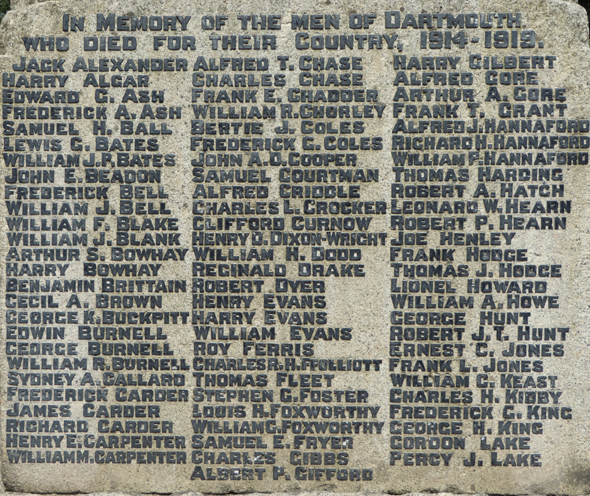
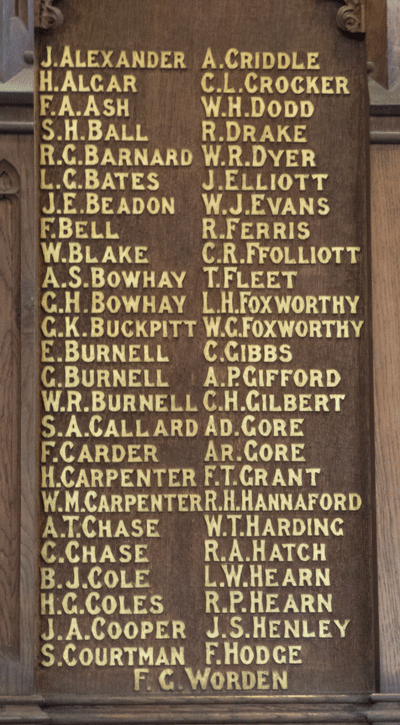
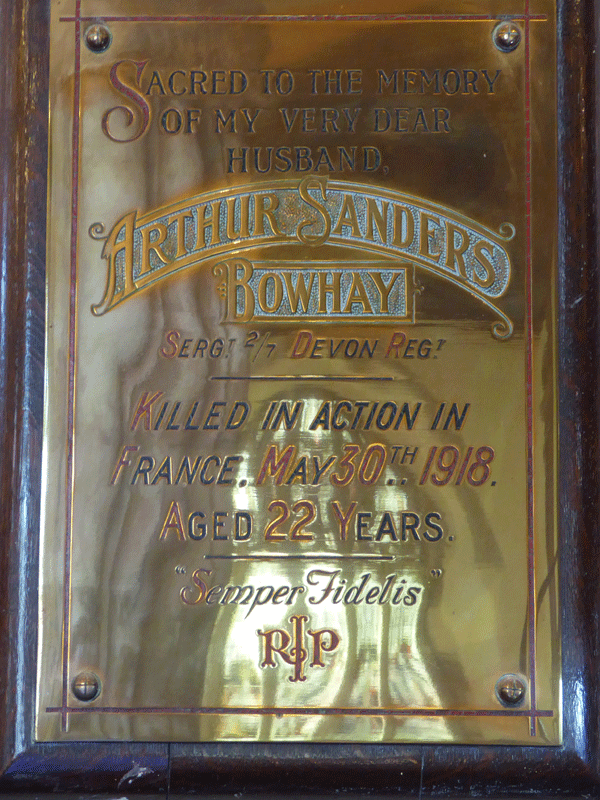
Norah also commissioned a private memorial to her husband, which is on the north aisle wall of St Saviours church, where the couple were married only a few months before Arthur's death. Reverend Simpson, for whom Arthur had worked as a gardener before the war, sought permission from the diocesan authorities for the memorial on 23rd September 1919. It seems that by this time, the date of Arthur's death had been officially confirmed as having occurred on 30th May 1918; this is also the date recorded by the Commonwealth War Graves Commission and is the date we have used on our database. However, uncertainty remained - the Worcestershire Regiment's Roll of Honour (as printed in the Regimental History of 1928) recorded Arthur's death as 18th June 1918, as did Soldiers Died in the Great War.
Norah chose to record her husband's service not in the Worcestershire Regiment but in the Devonshire Regiment, and quoted the Regiment's motto: "Semper Fidelis" (Always Faithful). This may also have been a reflection on her own devotion to him. She did not remarry.
She gave his age as 22, indicating that he had died just short of his 23rd birthday.
Sources
The Bowhays of Dartmouth, available on the Dartmouth History Research Group website, 102048
The Worcestershire Regiment in the Great War, Volume Two, by Captain H FitzM. Stacke, MC, publ G T Cheshire & Sons 1928, reprinted Naval & Military Press 2002, digital verson Andrews UK Ltd 2013
History of the Great War, Military Operations France and Belgium, Volume III, complied by Brigadier General Sir James E Edmonds, publ Macmillan 1938
Information Held on Database
| Surname: | Bowhay |
| Forenames: | Arthur Sanders |
| Rank: | Sergeant |
| Service Number: | 207241 |
| Military Unit: | 10th Bn Worcestershire Regiment |
| Date of Death: | 30 May 1918 |
| Age at Death: | 22 |
| Cause of Death: | Killed in action |
| Action Resulting in Death: | Battle of the Aisne |
| Place of Death: | See story |
| Place of Burial: | Commemorated Soissons Memorial France |
| Born or Lived in Dartmouth? | Yes |
| On Dartmouth War Memorial? | Yes |
| On St Saviour's Memorials? | Yes |
| On St Petrox Memorials? | No |
| On Flavel Church Memorials? | No |
| In Longcross Cemetery? | No |
| In St Clement's Churchyard? | No |
| On a Private Memorial? | Yes |
| Name of Private Memorial: | Plaque to Arthur Sanders Bowhay, St Saviours, Dartmouth |
| On Another Memorial? | Yes |
| Name of Other Memorial: | Soissons Memorial |















